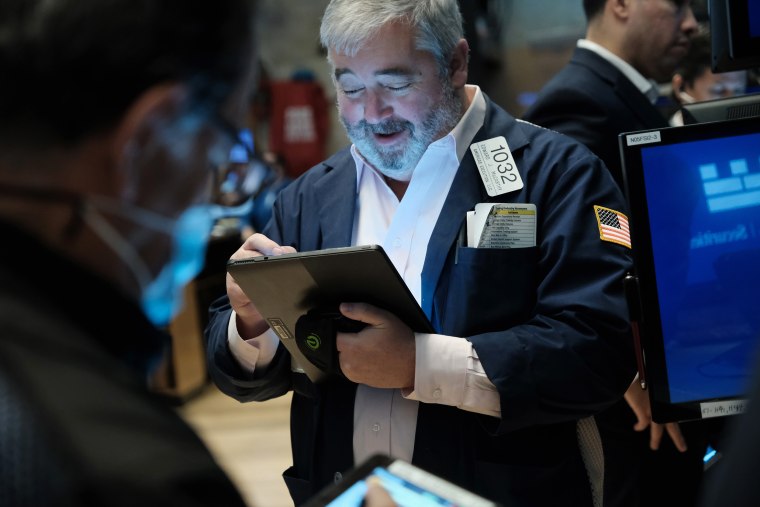Stocks surged to record highs Monday, buoyed by fresh optimism about the government spending that would be unlocked by the passage of President Joe Biden’s infrastructure plan.
The S&P 500 closed above 4,700 for the first time, and the Dow Jones Industrial Average added over 100 points, to close at 36,432.
The $1 trillion bill, formally called the Investing in Infrastructure and Jobs Act, cleared its final legislative hurdle late Friday with passage by the House of Representatives and now awaits the president’s signature.
“I definitely think this is a nice shot in the arm,” said Eric Diton, president and managing director of The Wealth Alliance. “There are clear beneficiaries … construction, steel, railroads.” Big industrial companies like equipment manufacturer Caterpillar and steel producers like U.S. Steel and Nucor got an immediate boost. The Global X U.S. Infrastructure Development ETF, known colloquially by its ticker symbol PAVE, rose as well.
Big industrial names like Caterpillar and U.S. Steel got an immediate boost.
Sameer Samana, senior global market strategist for Wells Fargo Investment Institute, said there were a few other categories that could see a lift from an infusion of spending on transportation, broadband, the electrical grid and green energy, like telecommunications and technology firms.
Designing and implementing projects will boost other types of businesses, he added. “A lot of construction and engineering firms tend to be involved from a planning and execution standpoint.”
A big reason for Wall Street’s cheer on Monday is that fulfilling the promise of investing big money into the nation’s aging infrastructure has been a long time coming, said Elizabeth Vermillion, equity analyst at CFRA.
“Obviously, it’s something companies in the industry have been waiting for, for going on about four years now,” she said. Although former President Donald Trump campaigned on his reputation as a developer, pledged to execute a $1 trillion infrastructure bill and announced a succession of “Infrastructure Weeks” over the course of his presidency, the promised investment never came to fruition, even as transportation officials, civil engineers, climate scientists and others warned that the United States badly needed to spend more to maintain, repair and update its roads, rails and power grid.
“There’s more room for price growth once there are more specifics,” Vermillion said. “Obviously, these projects are long-term things. There’s definitely a lot of upside going forward” — anywhere from two to six years, she said.
The caveat to investors eagerly awaiting for a surge of demand for materials and workers is the prospect of ordinary Americans competing with multinational corporations for everything from gasoline to gypsum.
“It probably means inflation is going to be a little bit stickier than a lot of folks expect,” Samana said, if demand for materials, energy and labor rises while the nation is stuck in the midst of a supply chain morass that is already driving prices across the board higher.
Samana suggested that the Federal Reserve might have to intercede by pulling back on accommodative policy sooner than expected. “If this is the case, next year we need to get going with respect to tapering and tightening,” he said.
By some accounts, the lack of “shovel-ready” projects might be a blessing in disguise, experts said, since delays would tend to push that demand for materials and labor further into the future, when economists anticipate that supply chain bottlenecks will have eased and inflation will have receded.
While policymakers as well as investing experts have differing viewpoints of the economic impact this bill will generate, Vermillion argued that this is almost beside the point, given the long-neglected state of much of the nation’s infrastructure. “There is a long-held belief that infrastructure spending is stimulus, and that’s not particularly proven. That’s not to say it’s not important,” she said. “We need infrastructure. Even if it’s not economic stimulus, it’s completely required and necessary.”
Market observers predict that the greatest benefits of all this building will be years in the future, and influential in ways it is hard to fully fathom today. These investments could fundamentally reshape where and how America lives, works and travels — delivering a potential boon for Wall Street as well as Main Street.
These investments could fundamentally reshape where and how America lives, works and travels.
A nationwide electric vehicle charging network would make cross-country drives feasible not only for road-trippers, but for the trucking fleets that currently burn gasoline or diesel, while more money for regional rail and light rail networks could alleviate traffic congestion in urban centers. An expansion of broadband into rural America would allow the pandemic-triggered trend of people leaving cities to live and work in more far-flung settings to continue apace.
“Especially in more Western states, there’s going to be an impact,” Vermillion said. “There are myriad benefits,” she said, such as knowledge economy firms expanding beyond high-priced technology hubs and rural students having access to more educational options.
“A bill like this promotes more economic growth across the whole economy — more people on the internet, more money going into electric vehicles and all this construction means more jobs. And whenever you get a broad benefit to the economy, it’s good for the stock market,” Diton said.
“If it goes as expected, it should help productivity in the broader economy, and that’s always a positive,” Samana said. “It’s the closest thing you get to a free lunch.”
